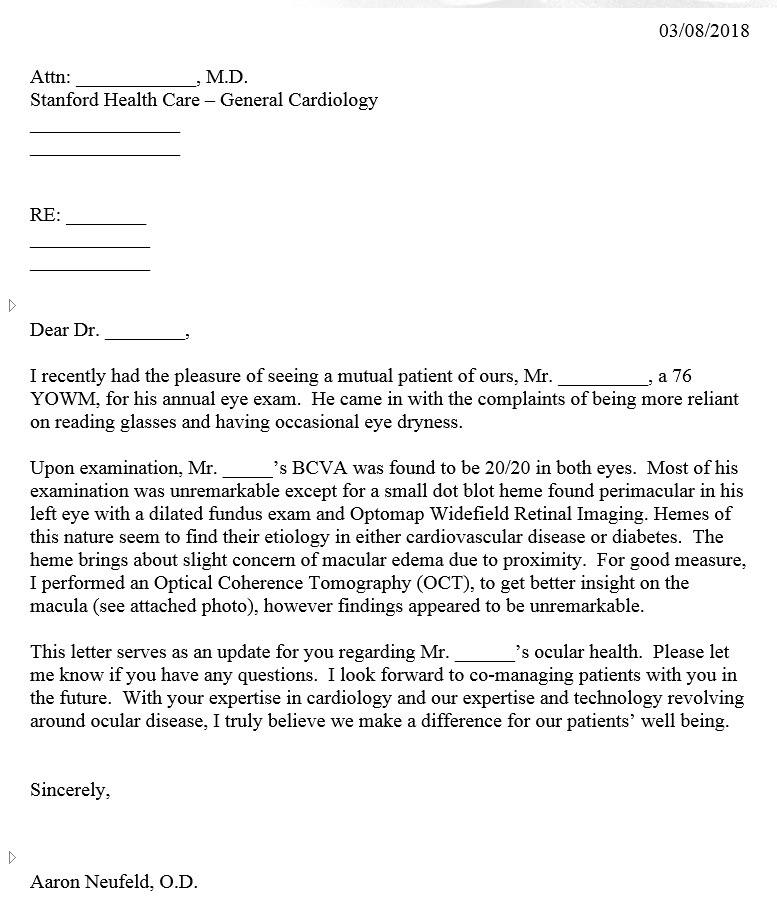By Aaron Neufeld, OD

April 4, 2018
A significant practice-builder for us has been referrals from other health care practitioners. Our patients also feel confident that, when necessary, we can refer them to the best local doctors.
My two-OD, one-location practice, co-manages with local cataract surgeons, refractive surgeons and corneal specialists, which make up the majority of our co-managing relationships, along with local corporate-owned optometry offices that refer us patients for specialty procedures such as orthokeratology, glaucoma treatment, dry eye management and foreign body removal. In addition, we co-manage with local hospitals, especially for patients who have diabetes or cardiovascular conditions.
Two other professionals our practice co-manages with that are much less obvious are podiatrists and chiropractors/physical therapists. Our relationship with podiatrists revolves around diabetic patients. The key to getting our foot in the door here (no pun intended), was to educate local podiatrists about diabetes’ strong correlation to complications in the eye and the importance of an organized approach to treatment and management. Our relationship with chiropractors and physical therapists began with my personal relationships. Many of them are frequent gym goers, as am I, and we use our gym time to refer patients to each other, as well as workout.
We would estimate that up to 5 percent of our patients have come to us through referral by another healthcare practitioner. Our practice grossed around $1.4 million last year, so these referrals present roughly $70,000 in revenue.
Tell Other Doctors Why & How They Should Send Patients to You
The key thing is to begin with why and how. Why does co-managing with us matter, and how does it help the other practice better serve their patients and grow? Whether it be in casual conversation at meetings, a mailed letter, or a formal in-office meeting, we try to get these two “whys” across. Additionally, we found with diseases that need multiple physicians to cross-manage, such as diabetes or cardiovascular conditions, sending an update letter to the patient’s primary care physicians and other tertiary physicians can help to generate referrals.

Example of a co-managing letter written by Dr. Neufeld, who notes the importance of regular, dependable, communication with other practices.
Send Personalized Letters to Co-Managing Doctors
I always send by secure means a personalized letter, written by myself. This has always been our practice.
The letter contains all pertinent information necessary for the other healthcare practitioner to have a clear picture of what is going on with each patient. The reason I write these letters instead of dictating, or having an EHR template write them, is that it allows me to take complete ownership of the specific case I am co-managing. I am able to include details that I think are necessary and leave out redundancies. In return, we expect letters of similar detail. This helps with providing the best care possible to patients, free of mistakes and potential overlap in treatment. All the offices we co-manage with have been great in providing timely and detailed reports about patients we are co-managing.
Set Time Aside At Least Once a Week to Correspond with Other Doctors
The main cost to generating co-management is time. You must put time aside to write letters and engage in conversation with other doctors. Real relationships are built through trust and confidence. Simply bombarding other doctors with junk mail-type newsletters (a local vision therapy practice near us is notorious for this) is not effective, and may be viewed in a negative light.
On the other hand, showing that you care by bringing yourself to meet with other doctors in-person plays a huge role in co-management. Setting aside a few hours per quarter, which normally means blocking out a half or full day, to meet with eye surgeons, PCPs and other doctors you co-manage with, is invaluable to building referral relationships.
Vet Doctors Before Referring to Them
Part of meeting face-to-face with other doctors is to build relationships with them, but also to vet their expertise and style of interacting with others. In the course of a friendly conversation, be sure to find out how many of the procedures, which you would be referring patients to them for, they have completed, along with data about the outcomes of those procedures. If you are referring for non-surgical reasons, you could ask about the protocol for managing the patients you send to them, such as how a PCP, or endocrinologist, provides care for diabetics.
State medical boards have online records about doctors that are available for public access. These are by far the best way to look up if a doctor is involved in a malpractice suit, or has had disciplinary action filed against them. A host of medical ratings web sites also are available online. However, many of these come from biased, or uninformed, perspectives, and must be taken with a grain of salt.
In addition to technical expertise, it is important to gauge how pleasant you find the doctor to interact with. Our biggest patient complaints from referral to other doctors has been in regard to the practitioner’s attitude or bedside manner.
Educate Patients So They Follow Through With Referral
It is vital to show a patient that a referral is a necessary step for the eye or general health. Educate them on the condition itself, the implications of the condition and the consequences that can occur if the condition is left untreated. Then explain what the referred-to physician will do, and how they their treatment will benefit the patient.
Finally, explain why are you referring to that specific physician. Show that you trust them, and that you have seen the quality of their work. Be excited to see the result after they are returned to your care.
A hypothetical example for a patient I am referring for cataract surgery: “Ms. Smith, it appears that we can’t get you seeing any better with glasses for contact lenses. That, plus your complaints of difficulty seeing at night, are the result of cataracts. [Pull out model eye and open patient education slides on computer screen] Cataracts are a clouding of the natural lens inside the eye, which is responsible for focusing light and allowing you clear vision. Over time, free radicals and UV light (as well as certain medications) can damage the lens and cause it to haze over. The result is similar to looking through a dirty windshield.
The good news is that your vision can be drastically better with cataract surgery. This involves breaking the lens into tiny pieces, removing it, and replacing it with an implant lens that could even correct your distance vision. Dr. Chang is our cataract surgeon of choice. He is one of the innovators of the surgical procedure, and has done thousands of surgeries. We meet with him every so often, and refer patients to him frequently. I have seen plenty of his work, and it is stellar. What questions do you have for me about cataracts or cataract surgery?”
 Aaron Neufeld, OD, is the owner of Los Altos Optometric Group in Los Altos, Calif. To contact: aneufeldod@gmail.com
Aaron Neufeld, OD, is the owner of Los Altos Optometric Group in Los Altos, Calif. To contact: aneufeldod@gmail.com























